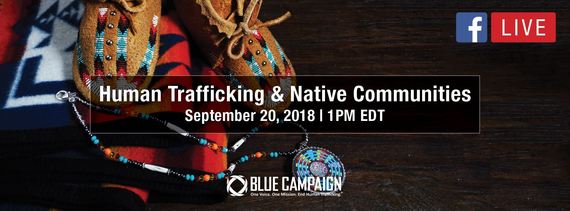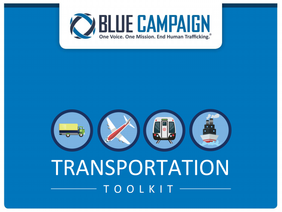In this issue:
In Case You Missed It: Facebook Live on Reporting Human Trafficking
Polaris and Immigration and Customs Enforcement Homeland Security Investigations (ICE HSI) came together to discuss what happens when you report human trafficking during a Blue Campaign Facebook Live in February. Panelists covered what to expect when calling the National Human Trafficking Hotline, how tips are investigated, and how victims are supported in the process. Watch the full conversation here: http://bit.ly/2BQ4dQH. 
Human Trafficking 101
It’s always a good time to revisit the indicators of human trafficking. Please share this content in newsletters, on websites, or repurpose it for social media sharing.
Human trafficking involves the use of force, fraud, or coercion to obtain some type of labor or commercial sex act. Every year, millions of men, women, and children are trafficked worldwide – including right here in the United States. It can happen in any community and victims can be any age, race, gender, or nationality. Traffickers might use violence, manipulation, or false promises of well-paying jobs or romantic relationships to lure victims into trafficking situations.
Language barriers, fear of their traffickers, and/or fear of law enforcement frequently keep victims from seeking help, making human trafficking a hidden crime. You can help identify potential victims by learning the key indicators of trafficking. Some common indicators to look for include:
PhysicalDoes the person...
- Show signs of physical and/or sexual abuse, physical restraint, confinement, or torture?
- Appear to be deprived of food, water, sleep, medical care, or other necessities?
- Lack personal possessions?
SocialDoes the person...
- Work excessively long and/or unusual hours?
- Show sudden or dramatic changes in behavior?
- Act fearful, anxious, depressed, submissive, tense, or nervous/paranoid?
- Defer to another person to speak for him or her?
- Appear to be coached on what to say?
- Appear disconnected from family, friends, community organizations, or place of worship?
- Not have the ability to leave where they live freely?
For more information about this heinous crime and how to help identify victims, check out our Human Trafficking 101 one-pager or the “What is Human Trafficking?" infographic. You can help raise awareness by sharing these resources online or displaying them in your office or community. View more Blue Campaign resources here.
Thank you for joining us in the fight against human trafficking.
The Blue Lightning Initiative (BLI), led by the Department of Homeland Security (DHS), U.S. Customs and Border Protection (CBP), and the Department of Transportation (DOT), is an element of Blue Campaign. BLI trains airline personnel to identify potential traffickers and human trafficking victims, and to report their suspicions to federal law enforcement.
The “BLI Corner” section of our newsletter will contain updates and stories related to the aviation industry and human trafficking.
BLI Hosts Stakeholder SummitBLI stakeholders recently met for a one-day summit to discuss the importance of human trafficking awareness and response training in the aviation industry. The summit attracted stakeholders from across the United States including air carriers, port authorities, industry associations, and law enforcement agencies.
Speakers at the summit included representatives from Blue Campaign, DOT, CBP, DHS, Immigration and Customs Enforcement (ICE), Delta Air Lines, JetBlue, Association of Flight Attendants-CWA (AFA), Anchorage International Airport, Federal Aviation Administration, and a human trafficking survivor and advocate.
To learn more about BLI and how you can play a role in combatting human trafficking, click here. 
Caption: Panelists answer questions regarding the role of their organizations in combating human trafficking at the BLI Stakeholder Summit (CBP Official Photo/Glenn Fawcett).
Health Professionals Learn How to Notice and Treat Victims of Human Trafficking(KRTV)
The America Unchained Project, in collaboration with the Montana Department of Justice, recently trained health care workers in Helena on how to notice and treat human trafficking victims. Nearly 88 percent of human trafficking victims will see a medical provider when they are in captivity, making it essential for health care workers to know the physical and verbal indicators of a trafficking victim, America Unchained Project founder Charity Perenzini told the group.
Blue Campaign can now be tagged on Twitter, Facebook, and Instagram using @DHSBlueCampaign. Each month we will share content you can distribute on your own social channels to raise awareness of human trafficking in your communities.
- Who are the victims of #humantrafficking? Who is at risk? Learn these answers and more from @DHSBlueCampaign: http://bit.ly/2GEcbAj
- Check out this infographic from @DHSBlueCampaign to learn more about the different types of #humantrafficking: http://bit.ly/2U48qam
- Learn the indicators of #humantrafficking and the differences between trafficking and smuggling with this pocket-sized card from @DHSBlueCampaign: http://bit.ly/2NlSZrD
- ICYMI: @DHSBlueCampaign @Polaris_Project @ICEgov discussed what happens when you report a #humantrafficking tip. Watch here: http://bit.ly/2BQ4dQH
For more information visit the Blue CampaignTo report suspected human trafficking: 1-866-347-2423To get help from the National Human Trafficking Hotline: 1-888-373-7888or text HELP or INFO to BeFree (233733)
| 






















